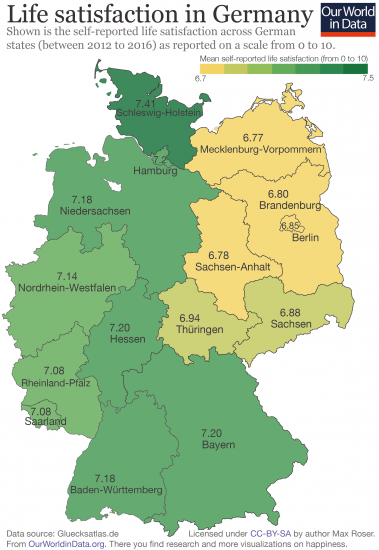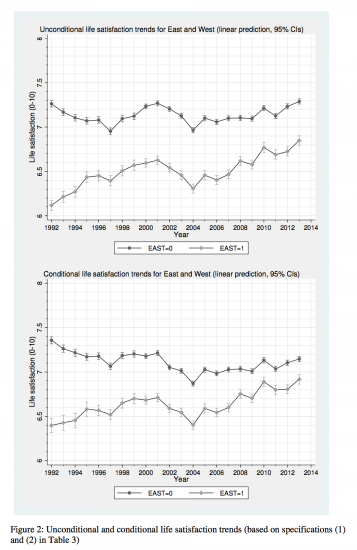In global surveys of happiness and life satisfaction, Germany usually ranks high. However, these national averages mask large inequalities. In the map shown we focus on regional inequalities—specifically the gap in life satisfaction between West and East Germany.
This map plots self-reported life satisfaction in Germany (using the 0-10 Cantril Ladder question), aggregating averages scores at the level of Federal States.1 What stands out is a clear divide between the East and the West, along the political division that existed before the reunification of Germany in 1990.
For example, the difference in levels between neighboring Schleswig-Holstein (in West Germany) and Mecklenburg-Vorpommern (in East Germany) are similar to the difference between Sweden and the US – a considerable contrast in self-reported life satisfaction.
Several academic studies have looked more closely at this ‘happiness gap’ in Germany using data from more detailed surveys, such as the German Socio-Economic Panel (e.g. Petrunyk and Pfeifer 2016).2 These studies provide two main insights:
First, the gap is partly driven by differences in household income and employment. But this is not the only aspect; even after controlling for socioeconomic and demographic differences, the East-West gap remains significant.

And second, the gap has been narrowing in recent years, as the chart shows. In fact, the finding that the gap is narrowing is true both for the raw average differences, as well as for the ‘conditional differences’ (i.e. the differences that are estimated after controlling for socioeconomic and demographic characteristics).
The observation that socioeconomic and demographic differences do not fully predict the observed East-West differences in self-reported happiness is related to a broader empirical phenomenon: Culture and history matter for self-reported life satisfaction—and in particular, ex-communist countries tend to have a lower subjective well-being than other countries with comparable levels of economic development.
Trends in life satisfaction for East and West Germany, 1992-2013
